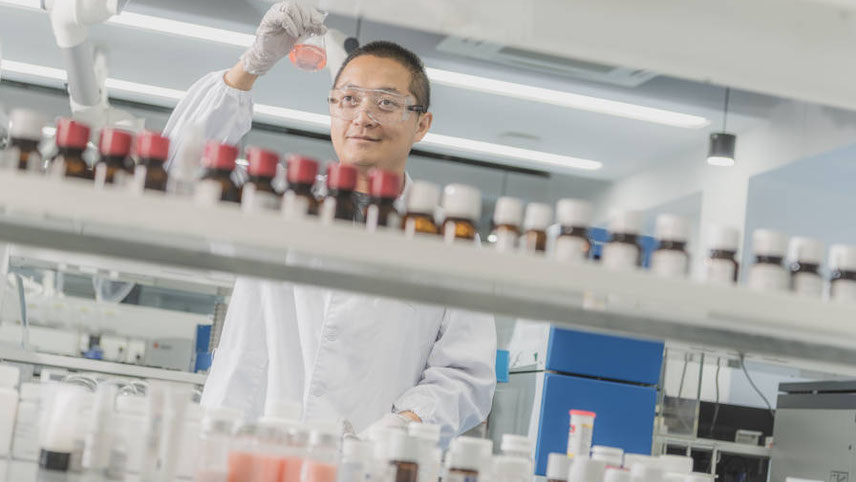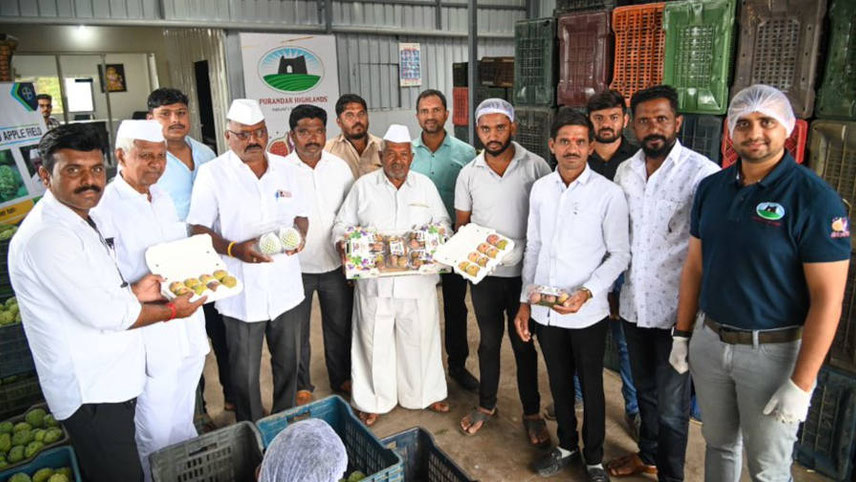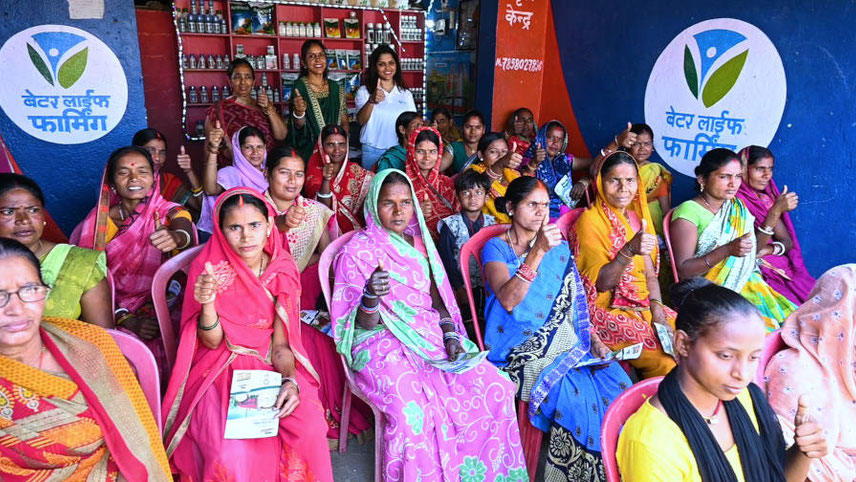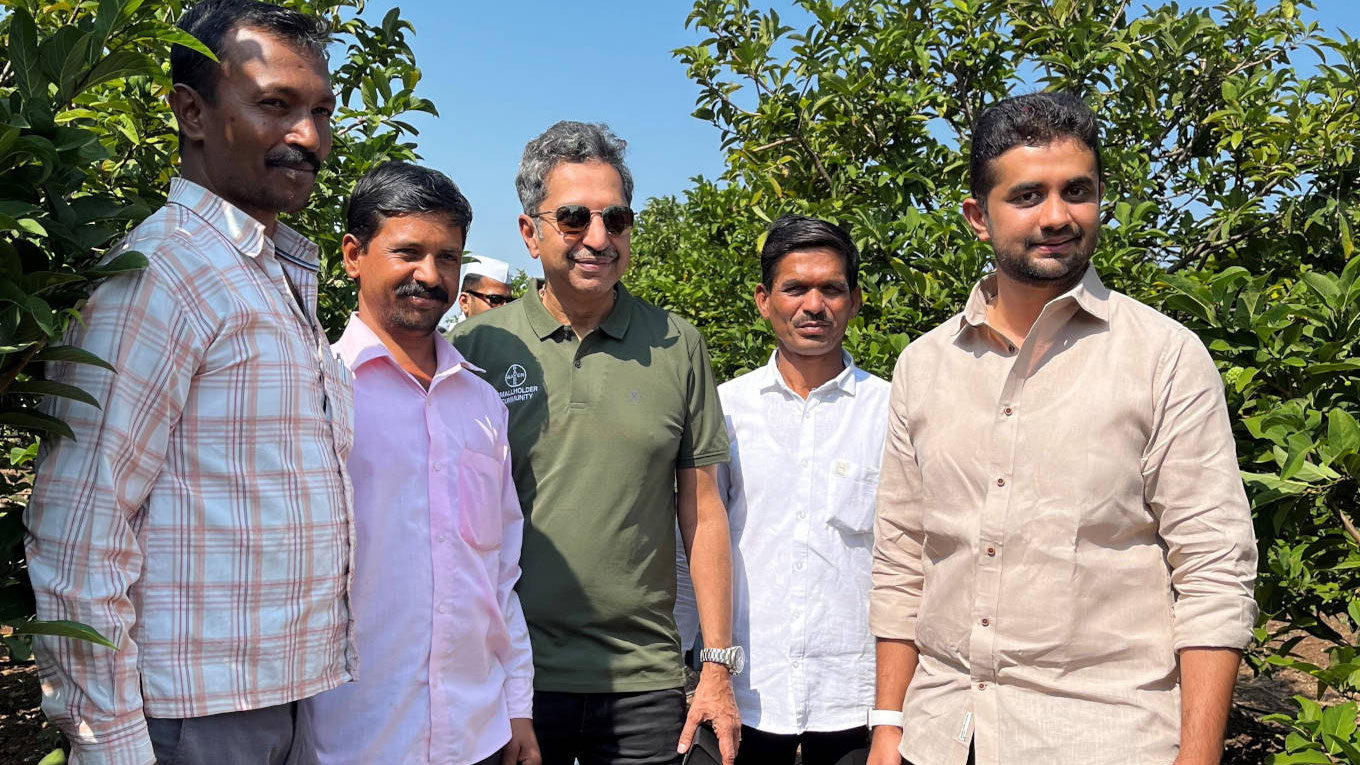-

Britsch: agro-chemicals contributed 81 per cent
125 and going strong
If one was to use a simple socio-economic term to sum up Bayer’s strategic basis for its crop science division one might call it another ‘bottom up’ instance. However, any market pundit will say that adopting a bottom-up approach in a geographically vast and culturally diverse country like India is no easy feat, especially for a multinational corporation. Nevertheless, Bayer’s confidence in making significant connections from seemingly small beginnings stems from its presence in India for over a century, granting it a deep understanding of the local market’s complexities.
“This legacy of 126-plus years is a substantial testimony to our journey in the country. The foundation is always built upon product technology and innovation across various businesses. People and talent are our other assets. The company’s present reputation is a result of our conduct over this entire period,” Narain emphasises. It is not difficult to extrapolate what the company’s senior South Asian executive is trying to say – Bayer is firmly established and adept at swiftly adapting to changes within the local ecosystem.
Here is a quick look at Bayer’s journey in India since it set foot in the country in 1895. Globally, the company, established in Germany in 1863 as a dyestuff manufacturing firm, saw its ties with India developing in the 1890s. It established a small supply line for delivering benzidine dyestuff to the Indian branches of English and German export houses as volume increased.
In 1896, the company established its fully owned subsidiary in India, which was a first for Asia. In its early years in India, Bayer primarily focused on supplying pharmaceutical products, which remained its mainstay for a considerable time. Post-Independence, Bayer’s first significant move into the field of crop science occurred when it established a small formulation plant for pesticides and a dedicated agrochemical unit.
Since then, the group has followed a steady growth trajectory, adapting to emerging opportunities in India such as the green revolution and post-reform changes in the Indian market, as well as pursuing strategic and tactical moves globally.
Globally, Bayer, which reported an earning of €50.73-billion last year and now prefers to identify as a life science business conglomerate, comprises three distinct divisions: CropScience (€25.16 billion), pharma (€19.25 billion), and consumer health (€6.08 billion). While the first two divisions serve as the pillars of the group, the healthcare division represents a relatively recent addition. In India, all three business divisions are present, supported by seven manufacturing sites (including a global site) and four breeding and R&D sites.
The company operates a range of Centres of Excellence that cater to a global audience in areas such as procurement, engineering and technology, data science, information technology for human resources, and finance support. Among its facilities, the Vapi plant in Gujarat, operational since 1992, stands out as the largest synthetic pyrethroids production facility globally.
Covering 85 acres, the Bayer Vapi site houses 13 manufacturing plants for 11 active ingredients and 11 intermediates. Another significant manufacturing site in Gujarat, located in Himatnagar and operational since 1991, specialises in the production of suspension concentrates (SC), water-dispersible granules (WG), and oil dispersion (OD). Presently, the Himatnagar site is a major exporter of WG products to various global regions. Additionally, Bayer's unit in the Union Territory of Dadra and Nagar Haveli, operational since 1996, focuses on manufacturing key herbicides for the company.
-

Wiebusch: engaging with smallholders is a crucial area
To cater to its large scale agri-support businesses, the company draws its strength from a host of advanced R&D centres. It operates an expansive 117-acre Mega Breeding Station (MBS) at Kallinayakanahalli in Chikaballapur district, near Bangalore, known for research in hybrid seeds, especially corn and vegetables. It has a dedicated Maize Breeding Centre located at Batheda Ki Sarai, Daroli, Udaipur. In 2013, the company set up another Multi-Crop Breeding Station (MCBS) in Chandippa near Hyderabad, which supports breeding and trait development (B&TD) activities for rice and cotton.
The driving force
Globally it is cropscience which leads the revenue stream and in India, the positioning of this unit is vital and is clearly the fulcrum of its presence. Its crop science division, which at the end of FY23 had reported an earning of over Rs5,100 crore, has been on a roll, giving the division a certain reputation among market leaders in a country where the agriculture and food businesses have grown phenomenally in the recent decade. The company’s crop-science division today has quite an expansive portfolio which includes crop protection and corn seeds, digital solutions and initiatives like drone services and direct seeded rice. These divisions are covered by the enlisted entity Bayer CropScience. Outside of the enlisted divisions’ purview, there are divisions like MPL (Monsanto Holdings Pvt Ltd) that specialises in vegetable seeds and BayerBio Science known for Arize Hybrid Rice Seeds and conducting a sustainable rice carbon program.
If one adds the earnings from these divisions (counted as part of the group’s global revenue of its agri-centric vertical), the total revenue of the crop science division would be much higher. The two other verticals – pharma and health care – are not enlisted and the company top brass does not disclose their earnings though a market analyst estimates the cumulative earning of the group comfortably exceeds $1 billion, and is probably somewhere in the vicinity of $1.2 billion. But they play a strong supporting role, especially the pharma division, which was the initial touchpoint for the group in India (see box: Supporting verticals).
The centrality of the agri-support business is evident from the fact that India ranks in the top five markets for Bayer's global crop science business. “India in crop science is among the top five markets globally, and it has shown significant business growth. We have strengthened our position, both in terms of top-line and profitability, managing the business holistically with new innovations,” says Narain. Bayer CropScience’s primary markets include the US, followed by Brazil, Argentina, Canada, and India.
The Indian cropscience division boasts an extensive portfolio of 272 brands encompassing 479 SKUs across crop protection, hybrid rice, corn, and vegetable seed categories. The company proudly asserts its ecosystem connects with 24 million farmers. Agro-chemical products claim the dominant share.
“During the year, domestic agro-chemicals contributed 81 per cent, and domestic corn seeds accounted for 13 per cent of total sales,” commented Simon Britsch, Chief Financial Officer for Bayer South Asia, during the last investor call. The sales were driven by agro-chemical product categories like Vayego, Laudis, and Council Activ, while horticulture, paddy, and corn seeds observed a modest uptick.
-

Bayer has a host of world class R&D centres
Market observers believe that Bayer's global acquisition of Monsanto in 2018 had implications for its Indian unit, enhancing its seed portfolio. “It has certainly bolstered Bayer CropScience’s seed offering, despite lacking supportive regulatory provisions for Genetically Modified seeds, which had been Monsanto's forte. If the regulatory landscape changes, the company stands to benefit significantly,” notes Ram Kaundinya, Director General of the Federation of Seed Industry of India (FSII).
Interestingly, some global analysts have questioned the merits of the deal (amounting to a staggering $63 billion, making it one of the most expensive corporate buyouts) due to reported challenges in integrating Bayer across various geographies. However, Narain asserts that the Indian scenario is distinct. “This is the best combination we could have hoped for, leveraging our strength in crop protection alongside Monsanto’s expertise in seeds and biotechnology. This fusion has resulted in substantial portfolio synergies and brought the industry’s finest talent together.”
Growing in partnership
The past five years have clearly witnessed a more modest growth uptick in the crop science division's business. The revenue has increased from approximately Rs3,600 crore to over Rs5,100 crore (see graphic: Revenue from Operations). During this period, there has been a strategic focus on expanding the reach to smallholders and involving them in a mutually beneficial equation.
“On average, Indian farmers own about two acres or two hectares of land. Engaging with smallholders has always been a crucial area for the company’s operations, as agriculture business in India inherently involves them. Historically, we might have primarily targeted more affluent farmers,” explains Simon-Thorsten Wiebusch, Country Divisional Head, Crop Science Division of Bayer for India, Bangladesh & Sri Lanka. He highlights that collectivisation, mechanisation, digitalisation, and sustainability constitute the four key strategic pillars for the division’s future growth.
The Purandar Highlands case serves as a prime example of how Bayer’s small-farm-centric approach is beginning to make a difference, particularly with selected partners in rural areas. The well-known FPO, Purandar Highlands, is now considering diversification into the production of branded packaged juice and has established a basic production plant nearby.
Engaging with FPOs has become a strategic initiative for Bayer. According to its latest annual report, the company has established connections with over 3,000 FPOs across the country and is directly supporting 50 of them. “Interacting with farmers has become more accessible due to this type of collective effort. This trend is expected to gain even more traction in the near future,” adds Wiebusch.
It’s not only partnerships with farmers that are driving Bayer’s commitment to expanding its reach in rural areas. The company is also collaborating with other players in the value chain through its Better Life Farming (BLF) program, a venture that has emerged from a collaboration involving the International Finance Corporation (IFC), Bayer, and Netafim.
While slated to become a global initiative in the coming years, BLF's origins lie in India. Local agricultural entrepreneurs are encouraged to establish outlets, which also serve as venues for training sessions. These entrepreneurs are provided with quality inputs to sell to the local community. An assigned group of agronomists, drawn from local ‘kisan kendras’ or nearby agricultural institutions, educate and train local farmers. Subsequently, the local BLF members assist in the final sales of produce where required. Within this initiative, BLFs operating in eastern Uttar Pradesh are facilitating the sale of local fruits and vegetables to platforms such as Big Basket. Presently, the company is engaged with approximately 1,550 such centres across the country.
-

Purandar Highlands farmers: a prime example of how Bayer’s small farm-centric approach makes a difference
Amit Maheshwari, Head of Business Development at Netafim India, underscores the program’s significance, stating: “This program is quite transformative as it provides us with the opportunity to explore new frontiers. For instance, we are specialists in micro-irrigation. Previously, we primarily reached out to large-scale farmers who were availing the benefits of government subsidy schemes for adopting micro-irrigation. However, under this program, we are now engaging with small farm holders. We will soon have 2,000 centres, where we plan to introduce more high-quality offerings. After India, the next step for this program is expected to be in Bangladesh."
Bayer CropScience has also kickstarted a dedicated app for the farming community – FarmRise – that uses satellite imagery for real-time information on crop health, weather forecast, pest and disease outbreaks. The platform is available in multiple languages. Plus, it also operates local level programmes like Bayer Gram and Sahbhagi to prepare a better-informed breed of local entrepreneurs well versed in digital tools.
Future scenario
Market experts emphasise that the agility displayed by top-tier agricultural input companies in recent years, aimed at establishing stronger connections with small farmers, is a result of a critical shift that many might overlook. This transformation has been unfolding within Indian agriculture in recent times. Over the past decade, the country has quietly witnessed a horticulture revolution, leading to a scenario where India now produces more vegetables and fruits than food grains. The surge in horticulture has consequently led to an increased demand for insecticides, pesticides, and advanced seed varieties.
“Engaging with small farmers has become a common objective for major agri-input companies. Bayer, Syngenta, BASF, Rallis, UPL, Corteva, and others are actively seeking to tap into this segment to expand their businesses,” highlights Kaundinya. Siraj Chaudhary, Former Chairman of Cargill India, notes: “FPOs have emerged primarily around the fruits and vegetables segment, drawing significant interest due to the promising agri-business prospects. Farmers require more support from input firms in the face of heightened risks from pests and insects.”
There are, however, stakeholders who believe that the path from FPOs to the future of agribusiness might not be as straightforward as it seems. Some are of the opinion that the most important factor for larger corporations engaging with small farmers through FPOs is establishing effective forward linkages. Without securing ultimate buyers for their produce, this approach might falter, leaving these corporations merely as input suppliers.
Moreover, the journey for FPOs in India is far from easy. Very few have achieved success thus far. Anil Ghanwat, a prominent farmer leader from Maharashtra, observes: “Similar to cooperatives, local-level power dynamics present a significant obstacle.”
Narain, in his response, doesn’t dismiss the theory that the maturity of the FPO ecosystem might still be in the future. It is his contention that substantial structural changes come with their own set of challenges, which require consistent efforts to address, including enhancing local capabilities. He underlines the broader perspective that the company has adopted: “Over the next two decades, India needs to almost double or triple horticulture production to meet demand, not just for exports but also for the domestic market. This presents a massive growth opportunity, positioning India globally as the largest horticulture market,” he asserts, recalling a recent statement by Rodrigo Santos, President (Global) of the CropScience division, where he projected that India could lead global agriculture in the coming decades.
-

While slated to become a global initiative in the coming years, Best Life Farming's origins lie in India
Simon Wiebusch adds that the Indian unit will further consolidate efforts in nutritional and sustainable agriculture. “Beyond food security, India’s new challenge lies in achieving nutritional security and wider adoption of sustainable agricultural practices. While we are just a small part of the system, we do contribute supportive solutions.”
As an illustration, while rice remains a major crop in India, analysts note that its heavy water consumption puts immense pressure on water resources. In response, Bayer CropScience has introduced Direct Seeded Rice (DSR), which promises a 30 per cent reduction in water consumption compared to traditional methods. “As a company, we are acutely aware of the need to promote water-efficient cropping patterns in the light of the growing water crisis. DSR could be just the starting point,” adds Rachna Panda, head of the Sustainability Division.
While the top brass remains tight-lipped about disclosing any specific financial milestones for the near-to-medium term, a recent report from a prominent brokerage firm suggests the potential addition of Rs1,000 crore to the current revenue of the crop-science division within the next 2 years, boosting its total topline to over Rs6,000 crore. In parallel, a significant transformation is unfolding within the agro-chemical marketplace, with India emerging as a global production powerhouse and experiencing a substantial surge in exports in recent years.
Does this suggest that Bayer CropScience is poised to expand this avenue from India in the future? “With our listed entity, our primary focus remains on serving the domestic market. While we do engage in some exports, they are more of an opportunistic nature,” explains CFO Simon Britsch, who was previously associated with Bayer's China and Vietnam divisions. Bayer CropScience seems to be eyeing enhanced opportunities within the Indian landscape, where substantial value creation is currently unfolding within its stronghold segment.
-

Saxena: impressive market share
Supporting pillars
While the CropScience division currently dominates Bayer AG’s presence in India, overlooking its pharma-centric verticals as minor aspects could prove to be a mistake. Bayer’s global business was restructured in 2015, leading to the creation of a dedicated consumer health division. When combined, the two units – dealing in prescription drugs (Bayer Pharmaceuticals) and over-the-counter offerings (Bayer Consumer Health) – comprise nearly half of its total business.
In India, the dedicated consumer health division was established in 2021, yet the original pharma division still commands a considerable presence. “Bayer initially began more as a health-focused entity, gradually building its entire chemical business,” emphasises Manoj Saxena, Country Division Head for South Asia at the Pharmaceuticals division of Bayer and Managing Director of Bayer Zydus Pharma. In India, the Pharmaceutical Division operates as Bayer Zydus Pharma, a joint venture between Bayer and Zydus Cadila, in which Bayer holds a 75 per cent stake. This venture covers key therapeutic areas, including Diabetes, Cardiology, Women’s Health, Oncology, and Ophthalmology.
Additionally, the division encompasses the Radiology business, involving devices and contrast agents. “Our extensive portfolio comprises over 60 SKUs. In women’s health, we focus on categories like endometriosis, PCOD, heavy menstrual bleeding, and contraception. In diabetes, we primarily emphasise diabetes management and chronic kidney disease. In cardiology, we deal with 3-4 segments – stroke prevention, CAD/PAD, VTE – and also products in the worsening heart failure space,” he elaborates.
While Saxena refrains from disclosing exact financial figures, he emphasises that the Indian business ranks among the top tier of Bayer’s pharma operations in emerging countries. In the Indian market, Bayer Pharma is estimated to hold an impressive market share of 20 per cent in oral contraceptives, which rises to around 40 per cent in Tier I markets. Moreover, the Indian unit's strategic significance extends to its role as a global clinical trials hub. “Currently, 17 clinical trials are ongoing in the country, with some in advanced stages – primarily phase 4 trials. Our trials for chronic kidney disease are also in phase 4,” he adds.
While expanding the innovation profile appears to be the pharma division’s key directive from group management, the recently established Consumer Health division is expected to bring added value from the rapidly growing healthcare-oriented over-the-counter businesses in the country. “In India, Crop Science and Pharma have had a longstanding presence, but Consumer Health was absent. We had out-licensed some of our brands to a third party in India.
However, to fulfil our mission of ‘health for all and hunger for none’ it was crucial for us to introduce a self-care division in India as well,” says Sandeep Verma, Country Head for Bayer's Consumer Health Division in India. The division already boasts a collection of well-established brands and products in categories such as analgesics, nutrition, allergy, and dermatology. These include brands like Saridon, Supradyn, Becozym, Benadon, Alaspan, Canestan, and Bayer's Tonic. With these offerings, the company claims to have reached approximately 60 million Indian households
-

Verma: aiming to reach 100 million households
Verma states that the consumer health division boasts several leading brands within its portfolio spanning 4-5 categories. These include Saridon, a market leader in pain management; Supradyn, offering vitamin and mineral supplements; Canesten, catering to the skincare or medicated skincare segment; and Alaspan, targeting the anti-allergy category. “Currently, we have ten brands present in India, and some of them are region-specific, such as Saridon, with its largest market being India,” he explains. Globally, Bayer Consumer Health maintains a diverse portfolio of approximately 150 brands, including the highly popular OTC offering, Aspirin.
Both the pharma and consumer health divisions have formed various local partnerships. About 50 per cent of the sales for Bayer Zydus Pharma and the entirety of Consumer Health’s sales are derived from products manufactured locally through third-party entities. Verma emphasises that with efficient production and distribution partnerships in place, the unit is poised to expand its Indian portfolio significantly in the years ahead, backed by an ambitious plan.
“Our goal is to penetrate as many consumer households as possible. We aim to reach 100 million households in India as soon as we can,” he reveals. When probed about the timeline, he projects the end of 2026 as the target period for achieving this milestone. “The domestic consumer health market is currently valued at around Rs35,000 crore. If you include Ayurveda offerings within the same category, it becomes a Rs50,000 crore annual market, likely to grow at 10-11 per cent in the near to medium term. This presents a substantial opportunity for all players,” he adds.









































